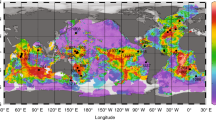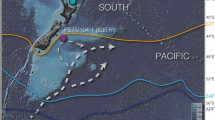Abstract
Weathering and erosion can affect the long-term ocean–atmosphere budget of carbon dioxide both through the consumption of carbonic acid during silicate weathering and through changes in the weathering and burial rates of organic carbon1,2,3,4. Recent attention has focused on increased silicate weathering of tectonically uplifted areas in the India–Asia collision zone as a possible cause for falling atmospheric CO2 levels in the Cenozoic era5,6,7. The chemistry of Neogene sediments from the main locus of sedimentary deposition for Himalayan detritus, the Bengal Fan, can be used to estimate the sinks of CO2 from silicate weathering and from the weathering and burial of organic carbon resulting from Himalayan uplift. Here we show that Neogene CO2 consumption from the net burial of organic carbon during Himalayan sediment deposition was 2–3 times that resulting from the weathering of Himalayan silicates. Thus the dominant effect of Neogene Himalayan erosion on the carbon cycle is an increase in the amount of organic carbon in the sedimentary reservoir, not an increase in silicate weathering fluxes.
This is a preview of subscription content, access via your institution
Access options
Subscribe to this journal
Receive 51 print issues and online access
$199.00 per year
only $3.90 per issue
Buy this article
- Purchase on Springer Link
- Instant access to full article PDF
Prices may be subject to local taxes which are calculated during checkout

Similar content being viewed by others
References
Garrels, R. M. & Perry, E. A. Cycling of carbon sulfur and oxygen through geologic time.in The Sea 303–336 (1974).
Lasaga, A. C., Berner, R. A. & Garrels, R. M. in The Carbon Cycle and Atmospheric CO2: Natural Variations, Archean to Present (eds Sundquist, E. T. &Broecker, W. S.) 397–410 (American Geophysical Union, Washington DC, 1985).
Berner, R. A. Atmospheric CO2levels over Phanerozoic time. Science 249, 1382–1386 (1990).
Walker, J. C. G., Hays, P. B. & Kasting, J. F. Anegative feed back mechanism for the long-term stabilization of Earth's surface temperature. J. Geophys. Res. 86, 9776–9782 (1981).
Raymo, M. E. & Ruddiman, W. F. Tectonic forcing of late Cenozoic climate. Nature 359, 117–122 (1992).
Molnar, P., England, P. & Martinod, J. Mantle dynamics, uplift of the Tibetan Plateau, and the Indian monsoon. Rev. Geophys. 31, 327–396 (1993).
Goddéris, Y. & François, L. M. Balancing the Cenozoic carbon and alkalinity cycles: Constraints from isotopic records. Geophys. Res. Lett. 23, 3743–3746 (1996).
Einsele, G., Ratschbacher, L. & Wetzel, A. The Himalaya–Bengal fan denudation accumulation system during the past 20 Ma. J. Geol. 104, 163–184 (1996).
France-Lanord, C., Derry, L. & Michard, A. in Himalayan Tectonics (eds Treloar, P. J. &Searle, M.) 603–621 (Geol. Soc. Lond., London, 1993).
Sayles, F. L. & Mangelsdorf, P. C. The equilibration of clay minerals with seawater: exchange reactions. Geochim. Cosmochim. Acta 41, 951–960 (1977).
Von Damm, K. L., Edmond, J. M., Grant, B. & Measures, C. K. Chemistry of submarine hydrothermal solutions at 21° N, East Pacific Rise. Geochim. Cosmochim. Acta 49, 2197–2220 (1985).
France-Lanord, C. Chevauchement, métamorphisme et magmatisme en Himalaya du Népal central. Etude isotopique H, C, O.Thesis, Institut National Polytechnique de Lorraine 1987.
Beck, R. A., Burbank, D. W., Sercombe, W. J., Olson, T. L. & Khan, A. M. Organic carbon exhumation and global warming during the early Himalayan collision. Geology 23, 387–390 (1995).
Shipboard Scientific Party. Initial Reports Sites 717-718-719 Distal Bengal Fan, Proc. ODP Init. Rep. (Ocean Drilling Program, College Station, TX, 1989).
Bouquillon, A., France-Lanord, C., Michard, A. & Tiercelin, J.-J. in Proc. ODP Sci. Res. (eds Cochran, J. R. et al. ) 43–58 (1990).
Derry, L. A. & France-Lanord, C. Neogene Himalayan weathering history and river 87Sr/86Sr: Impact on the marine Sr record. Earth Planet. Sci. Lett. 142, 59–74 (1996).
Martin, J. M. & Meybeck, M. Element mass-balance of material carried by major world rivers. Mar. Chem. 7, 173–206 (1979).
Sarin, M. M., Krishnaswami, S., Dilli, K., Omayajulu, B. l. K. & Moore, W. S. Major ion chemistry of the Ganga–Brahmaputra river system: Weathering processes and fluxes to the Bay of Bengal. Geochim. Cosmochim. Acta 53, 997–1009 (1989).
Gardner, R. & Walsh, N. Chemical weathering oif metamorphic rocks from low elevations in the southern Himalaya. Chem. Geol. 127, 161–176 (1996).
France-Lanord, C. & Derry, L. A. δ13C or organic carbon in the Bengal fan: source evolution and transport of C3 and C4 plant carbon to marine sediments. Geochim. Cosmochim. Acta 58, 4809–4814 (1994).
Bouquillon, A. Influence continentale et marine dans les sediments Cénozoiques de l'océan Indien Nord Oriental. Thesis, Université de Lille Flandres-Artois (1987).
Berner, R. A. & Berner, E. Global Environment: Water, Air, and Geochemical Cycles 1–376 (Prentice Hall, Upper Saddle River, NJ, 1994).
Michalopoulos, P. & Aller, R. C. Rapid clay mineral formation in Amazon delta sediments: Reverse weathering and oceanic elemental cycles. Science 270, 614–617 (1995).
Milliman, J. D. & Syvitski, P. M. Geomorphic/tectonic control of sediment discharge ot the ocean: the importance of small mountainous rivers. J. Geol. 100, 525–544 (1992).
Shackleton, S. J. & Hall, M. A. Carbon isotope data from Leg 74 sediments.in Init. Rep. DSDP (eds Moore, T. C. et al. ) 613–619 (US Govt Printing Office, Washington, 1984).
Derry, L. A. & France-Lanord, C. Neogene growth of the sedimentary organic carbon reservoir. Paleoceanography 11, 267–275 (1996).
Berner, R. A. & Canfield, D. Amodel for atmospheric oxygen over Phanerozoic time. Am. J. Sci. 289, 333–361 (1989).
Hedges, J. I. & Keil, R. G. Sedimentary organic matter preservation: an assessment and speculative synthesis. Mar. Chem. 49, 81–90 (1995).
Raymo, M. E. The Himalayas, organic carbon burial, and climate in the Miocene. Paleoceanography 9, 399–404 (1994).
Caldeira, K. Enhanced Cenozoic chemical weathering and the subduction of pelagic carbonate. Nature 357, 578–581 (1992).
Subramanian, V. & Ittekkot, V. Carbon transport by the Himalayan rivers.in Biogeochemistry of Major World Rivers, SCOPE (eds Degens, E. T., Kempe, S. &Richey, J. E.) 157–168 (Wiley, Chichester, 1991).
Ittekkot, V. Global trends in the nature of organic matter in river suspensions. Nature 332, 436–438 (1988).
Acknowledgements
We thank Patrick Le Fort for providing part of the Himalayan samples and analyses. This study was supported by the CNRS-INSU program ‘Dynamique et Bilan de la Terre-Fleuve et Érosion’.
Author information
Authors and Affiliations
Corresponding author
Rights and permissions
About this article
Cite this article
France-Lanord, C., Derry, L. Organic carbon burial forcing of the carbon cycle from Himalayan erosion. Nature 390, 65–67 (1997). https://doi.org/10.1038/36324
Received:
Accepted:
Issue Date:
DOI: https://doi.org/10.1038/36324
This article is cited by
-
Composition and vertical distribution of organic matter in Central Indian Ocean sediment cores
Scientific Reports (2024)
-
Fossil organic carbon utilization in marine Arctic fjord sediments by subsurface micro-organisms
Nature Geoscience (2023)
-
Neogene burial of organic carbon in the global ocean
Nature (2023)
-
Hydrochemistry and carbon isotope characteristics of Nujiang River water: Implications for CO2 budgets of rock weathering in the Tibetan Plateau
Science China Earth Sciences (2023)
-
Degassed versus Consumed Flux of CO2 from the Third Pole
Journal of the Geological Society of India (2023)
Comments
By submitting a comment you agree to abide by our Terms and Community Guidelines. If you find something abusive or that does not comply with our terms or guidelines please flag it as inappropriate.



